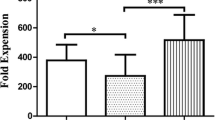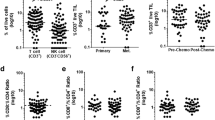Summary
We have compared the growth and tumordirected cytotoxic efficacy of recombinant-interleukin-2-(rIL-2)-activated peripheral blood (PBL) and tumor-infiltrating lymphocytes (TIL) from patients with epithelial ovarian carcinoma. These studies demonstrated that TIL and PBL displayed similar levels of cytotoxicity and a broad range of target cell killing, as exemplified by their reactivity against autologous and allogeneic ovarian tumors as well as against tumor cell lines. No specificity of autologous tumor cell killing was manifested by TIL. Even though TIL of some patients showed higher proliferative activity (especially at the later times in rIL-2 culture) this was not a general phenomenon. In fact, in one case TIL did not proliferate at all, and in the other case the PBL proliferated more actively. While the cultures were composed primarily of CD3+ lymphocytes, the major cytotoxic cells displayed the CD56+ and CD16+ phenotype. Addition of OKT3 mAb to rIL-2 cultures resulted in an increased proliferative index, but showed only a minor effect on the cytotoxic potential of cultured lymphocytes. The therapeutic potential of rIL-2-activated TIL and PBL is discussed.
Similar content being viewed by others
References
Heo DS, Whiteside TL, Johnson JT, Chen K, Barnes EL, Herberman RB (1987) Long-term interleukin-2 dependent growth and cytotoxic activity of tumor-infiltrating lymphocytes from human squamous cell carcinomas of the head and neck. Cancer Res 47: 6353
Heo DS, Whiteside TL, Kanbour A, Herberman RB (1988) Lymphocytes infiltrating human ovarian tumors. I. Role of Leu-19 (NKH1)-positive recombinant IL-2-activated cultures of lymphocytes infiltrating human ovarian tumors. J Immunol 140: 4042
Itoh K, Platsoucas CD, Balch CM (1988) Autologous tumor-specific cytotoxic T lymphocytes in the infiltrate of human metastatic melanomas. Activation by interleukin-2 and autologous tumor cells, and involvement of the T cell receptor. J Exp Med 168: 1419
Kedar E, Ikejiri BL, Bonnard GD, Herberman RB (1982) A rapid technique for isolation of viable tumor cells from solid tumors: use of the tumor cells for induction and measurement of cell-mediated cytotoxic responses. Eur J Cancer Clin Oncol 18: 991
Lotzová E, Savary CA, Herberman RB (1987) Induction of NK cell activity against fresh human leukemia in culture with interleukin-2. J Immunol 138: 2718
Lotzová E, Savary CA, Herberman RB, McCredie KB, Keating MJ, Freireich EJ (1987) Augmentation of antileukemia lytic activity by OKT3 monoclonal antibody: synergism of OKT3 and interleukin-2. Nat Immun Cell Growth Regul 6: 219
Lotzová E, Savary CA, Freedman RS, Edwards CL, Wharton JT (1988) Recombinant IL-2-activated NK cells mediate LAK activity against ovarian cancer. Int J Cancer 42: 225
May PM, Holmes EC, Golub SH (1985) Depression of natural killer cytotoxic activity in lymphocytes infiltrating human pulmonary tumors. Cancer Res 45: 57
Miescher S, Whiteside TL, Carrel S, von Fliedner V (1986) Functional properties of tumor-infiltrating and blood lymphocytes in patients with solid tumors: effects of tumor cells and their supernatants on proliferative responses of lymphocytes. J Immunol 136: 1899
Miescher S, Stoeck M, Whiteside TL, Leyvraz S, Ruzicka J, Schindler AM, Givel JC, Mosimann F, von Fliedner V (1988) Altered activation pathways in T lymphocytes infiltrating human solid tumors. Transplantat Proc 20: 344
Muul LM, Spiess PJ, Director EP, Rosenberg SA (1987) Identification of specific cytolytic immune responses against autologous tumor in humans bearing malignant melanoma. J Immunol 138: 989
Ochoa AC, Gromo G, Alter BJ, Sondel PM, Bach FH (1987) Longterm growth of lymphokine-activated killer (LAK) cells: role of anti-CD3, β-IL-1, interferon-γ and -β. J Immunol 138: 2728
Rosenberg SA, Lotze MT, Muul LM, Leitman S, Chang AE, Ettinghausen SE, Matory YL, Skibber JM, Shiloni E, Vetto JT, Seipp CA, Simpson C, Reichert CM (1985) Observations on the systemic administration of autologous lymphokine-activated killer cells and recombinant interleukin-2 to patients with metastatic cancer. N Engl J Med 313: 1485
Rosenberg SA, Spiess P, Lafreniere RL (1986) A new approach to the adoptive immunotherapy of cancer with tumor-infiltrating lymphocytes. Science 233: 1318
Svennevig JL, Lunde OC, Holter J, Bjorgsvik D (1984) Lymphoid infiltration and prognosis in colorectal carcinoma. Br J Cancer 49: 375
Takagi S, Chen K, Schwarz R, Iwatsuki S, Herberman RB, Whiteside TL (1989) Functional and phenotypic analysis of tumorinfiltrating lymphocytes isolated from human primary and metastatic liver tumors and cultured in recombinant interleukin-2. Cancer 63: 102
Topalian SL, Muul LM, Solomon D, Rosenberg SA (1987) Expansion of human tumor infiltrating lymphocytes for use in immunotherapy trials. J Immunol Methods 102: 127
Topalian SL, Solomon D, Avis FP, Chang AE, Freerksen DL, Linehan WM, Lotze MT, Robertson CN, Seipp CA, Simon P, Simpson CG, Rosenberg SA (1988) Immunotherapy of patients with advanced cancer using tumor-infiltrating lymphocytes and recombinant interleukin-2: a pilot study. J Clin Oncol 6: 839
Totterman TH, Hayry P, Saksela E, Timonen T, Eklund B (1978) Cytological and functional analysis of inflammatory infiltrates in human malignant tumors. II. Functional investigations of the infiltrating inflammatory cells. Eur J Immunol 8: 872
Uchida A, Micksche M (1983) Lysis of fresh human tumor cells by autologous peripheral blood lymphocytes and pleural effusion lymphocytes activated by OK432. JNCI 71: 673
Vose BM, Moore M (1979) Suppressor cell activity of lymphocytes infiltrating human lung and breast tumors. Int J Cancer 24: 579
Vose BM, Vanky F, Klein E (1977) Human tumour-lymphocyte interaction in vitro. V. Comparison of the reactivity of the tumour-infiltrating, blood and lymph-node lymphocytes with autologous tumour cells. Int J Cancer 20: 895
Whiteside TL, Heo DS, Takagi S, Johnson JT, Iwatsuki S, Herberman RB (1988) Cytolytic antitumor effector cells in long-term cultures of human tumor-infiltrating lymphocytes in recombinant interleukin 2. Cancer Immunol Immunother 26: 1
Wolf GR, Hudson JL, Peterson KA, Miller HL, McClatchey KD (1986) Lymphocyte subpopulations infiltrating squamous carcinomas of the head and neck: correlations with extent of tumor and prognosis. Otolaryngol Head Neck Surg 95: 142
Author information
Authors and Affiliations
Additional information
Recipient of the Florence Maude Thomas Cancer Research Professorship
Rights and permissions
About this article
Cite this article
Lotzová, E., Savary, C.A., Freedman, R.S. et al. Comparison of recombinant-interleukin-2-activated peripheral blood and tumor-infiltrating lymphocytes of patients with epithelial ovarian carcinoma: Cytotoxicity, growth kinetics and phenotype. Cancer Immunol Immunother 31, 169–175 (1990). https://doi.org/10.1007/BF01744732
Received:
Accepted:
Issue Date:
DOI: https://doi.org/10.1007/BF01744732




